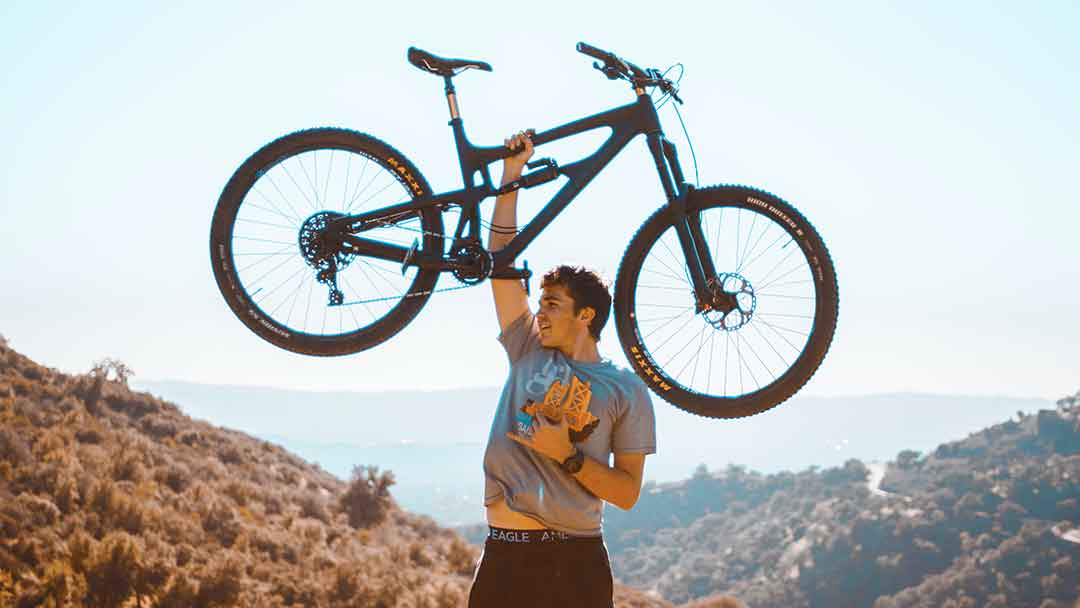Can You Bikepack On A Full Suspension Mountain Bike?

As an Amazon Associate we earn from qualifying purchases made on our website. If you make a purchase through links from this website, we may get a small share of the sale from Amazon and other similar affiliate programs. You can read our complete legal information for more details. By using this site, you agree the information contained here is for informational purposes only. For specific medical questions, consult your doctor. NO information on this site should be used to diagnose, treat, prevent or cure any disease or condition.
My very first bike was a road bike. I didn’t like the slim tires and light frame since I enjoy going into the forest. That’s when I switched over to a mountain bike and fell in love. But what kind of mountain bike is best for bikepacking?
You can bikepack with a full-suspension mountain bike. They’re generally more expensive than a hardtail mountain bike, but this might be worthwhile if you plan on going through a rough area. These bikes handle rocky, sandy, and unpaved terrain better than most bikes, making them ideal for the wilderness.
What sets a full-suspension mountain bike apart from other mountain bikes? How much weight can they carry? Keep reading to learn more!
What is a Full Suspension Mountain Bike?
A full-suspension mountain is a specialized bike designed for off-road riding. They have suspension on both the front and back of the bike, which absorbs most of the friction and shock when going over a bump.
They’re more expensive than hardtail bikes which have front suspension only.
Full-suspension mountain bikes are designed for hardcore biking. They’re sturdy yet flexible and handle hills and rugged terrain without damage. The extra suspension also protects the rider from chaffing and bruising.
Some of the main perks of choosing this bike for bikepacking include the following:
- Less friction
- Longer bike rides
- Handles off-roading
- Capable of handling rocky terrain
However, some of the downsides to this bike include the following:
- Expensive
- Intense maintenance
- Excessive unless necessary
Most consider these bikes non-essential. This is because they tend to be over $1,000.00 and aren’t especially unique except for their suspension.
However, this isn’t meant to deter you from investing in this bike.
This is a better, long-term choice if you plan to go mountain biking. Not only does it resist breaking, but it can be ridden for longer periods harming your back and bottom less.
These are some common injuries from extensive riding:
Of course, there are some ways to mitigate these issues. You can get a more supportive seat, use a cushion, and utilize various stretching exercises.
But a suspension bike will likely improve your well-being as well.
More suspension means you’ll get less of a jolt when riding over tree roots, rocks, and rough terrain.
This will help save your back, hips, and bottom a lot of pain and grief. Rather than the jolt being absorbed by your body, the bike suspension will absorb it!

How Does a Full Suspension Mountain Bike Differ From Other Bike Varieties?
Full suspension bikes differ from most mountain bikes in two main ways: suspension and traction.
Most mountain bikes only have suspension in either the front or back and have mild traction to handle slick roadways.
Full-suspension mountain bikes have suspension in the front and back, making traction and handling easier.
If you plan to traverse some steep slopes with little traction, a full-suspension bike is a better idea.
They’re set apart primarily for their suspension, which creates a smoother ride. This makes descent and ascents on rocky, slick terrain much easier.
They don’t provide much “feedback” or bumps and jostles while riding as traditional bikes. Although they’re typically compared to hardtails, we’ll also briefly discuss how they differ from other traditional bike models.
Some of the most common bikes include:
The concept of “Bicycle” is pretty ubiquitously understood in the English-speaking world. But the different types actually differ rather significantly.
Road bikes are designed to be sleek and lightweight.
Compared to a full suspension, these bikes are significantly lighter and meant for riding on fully paved surfaces.
While they’re excellent for races and endurance rides, they’d break easily on mountain paths.
E-bikes are a popular trend right now. While they’re an excellent environmental choice over a car, they’re not an authentic bike experience, plus they aren’t great for riding off-road since they may require maintenance and recharge.
Finally, the last two varieties, cruisers and touring bikes are heavy-weight.
They’re designed to carry heavier objects long distances. However, they aren’t designed for steep inclines and constantly shifting terrain.

What Should You Look For in a Full Suspension Bike?
The size is one of the first things to consider when selecting your first full-suspension bike.
Full-suspension mountain bikes are designed to handle different types of riders and journeys.
Generally, smaller bikes are better for small-framed riders going on a day trip, while larger bikes are designed to hold heavier riders for longer rides.
Full-suspension mountain bikes generally come in the following sizes:
- Small, short-travel bike
- Medium, longer travel bike
- Large, long-term travel bike
- Large, 29ers
The basic distinctions in these designs are size, weight, and capacity.
Small, short sprint bikes listed on top are designed for day trips. If you like taking a day-long excursion on rough mountain terrain, then this one is right for you.
However, they’re not ideal for long, week, or month-long bike trips. If you enjoy bikepacking, for example, you’ll want to get a medium-sized or larger bike.
These bikes are heavier and have more space for carrying supplies. This extra space does impact the price and weight, so they might be too much for simple day trips.
Full suspension 29er bikes are called such for the size of their wheels.
These bikes have excellent traction and are the best option for riding on steep mountainsides. They also handle rivers and wet terrain better than smaller wheeled bikes.

Is Full Suspension Better Than Hardtail?
Neither a hardtail nor a full-suspension bike is better, per se. Rather, they serve a different purpose and are better suited for separate endeavors.
Generally, hardtail bikes are faster, while full-suspension bikes are better for rough terrain.
Some of the main benefits of a hardtail versus a full suspension bike include:
- Lighter weight
- Less friction
- Best for cross-country biking/racing
- Handles incline and declines well
- Best for beginners
- Sometimes cheaper
Hardtail bikes are better for racing and paved or well-packed surfaces. They have decent traction and can handle some dirt paths.
However, they don’t have the handling capabilities of a full-suspension bike.
Some of the main perks of a full-suspension bike include the following:
- Sturdier
- Less pain when riding
- Better traction
- Handles unpaved and minimally traveled paths
- Handles tree roots and rocks on pathways
This is the best choice for anyone looking to ride on a rough road in the woods or mountains.
The extra weight adds a level of stability which is desirable in rough terrain. However, the weight can weigh you down during a race or cross-country speed test.
Emily Batty, a professional mountain biker, discusses the pros and cons in detail in this informative video! Check it out for a detailed breakdown of each style’s different pros and cons.
Are Full Suspension Mountain Bikes Harder To Pedal?
Full-suspension bikes aren’t necessarily harder to pedal than other mountain bikes.
However, they are significantly heavier than other bike models. This can create more friction while traveling up and downhill, slowing you down.
How Much Weight Can A Full Suspension Bike Carry?
Full-suspension bikes can typically carry a similar amount of weight as other mountain bikes. This means you can expect your full suspension bike to carry between 300-400 pounds on average.
However, remember that the bike itself is heavier than most, so you should keep excess luggage to a minimum.
Also, how you distribute weight on your bike can have an impact on rideability. This guide explains how to pack weight correctly on your bike.

Closing Thoughts
Full suspension bikes are typically high-quality bikes to purchase. They can cost upwards of $1,500.00, though, so you might want to weigh the benefits prior to purchasing.
They make for a seamless ride even on the roughest terrain. But they might be unnecessary for most mountain biking excursions.
Consider where you want to travel and how long you want to travel before making your choice! They’re a great choice for bikepacking if you plan on going to the extreme on some rugged roadways.
Free Biking Resources:
- Bike Touring Packing List (Printable PDF)
- Complete Bike Touring Cooking Guide
- How To Select Gears for a Touring Bike
- Bikepacking Hammock Setup Guide
Sources:
REI-COOP: Full-Suspension vs. Hardtail Mountain Bikes
Bicycle.com: How to Avoid Lower Back Pain from Biking, According to Experts
Refinery: How To Make Bike Seats More Comfortable On Your Butt
ISSA: Hip Pain Cycling Exercises – Take the Pain out of Biking
Bike work today: Hardtail vs Full Suspension Mountain Bike: Which is Better?
Bike Radar: What is a road bike? The basics explained
Bicycling: What Is an E-Bike? Here’s Everything You Need to Know
Bike America: Buyer’s Guide To Full-Suspension Bicycles
Bikepacking: WHAT IS BIKEPACKING?
Bike lock Wiki: What Is a 29er Bike?
Trek Bike: Hardtail vs. Full Suspension: which is right for you?
YouTube: Trek Bicycle: Mountain Bikes: Full Suspension vs. Hardtail



